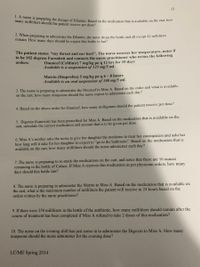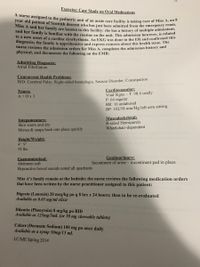
Phlebotomy Essentials
6th Edition
ISBN: 9781451194524
Author: Ruth McCall, Cathee M. Tankersley MT(ASCP)
Publisher: JONES+BARTLETT PUBLISHERS, INC.
expand_more
expand_more
format_list_bulleted
Question
Solve questions 1-10 using dosage and calculations.

Transcribed Image Text:1. A nurse is preparing the dosage of Dilantin. Based on the medication that is available on the cart, how
13
many milliliters should the patient receive per dose?
2. When preparing to administer the Dilantin, the nurse drops the bottle and all except 42 milliliters
remain. How many days should he expect this bottle to last?
The patient states: “my throat and ear hurt", The nurse assesses her temperature, notes il
to be 102 degress Farenheit and contacts the nurse practitioner who writes the following
orders:
Omnicef (Cefdinir) 7 mg/kg po q 12 hrs for 10 days
Available is a suspension of 125 mg/5 mL
Motrin (Ibuprofen) 5 mg/kg po q 6 – 8 hours
Available is an oral suspension of 100 mg/5 ml.
3. The nurse is preparing to administer the Omnicef to Miss A. Based on the order and what is available
on the cart, how many teaspoons should the nurse expect to administer each day?
4. Based on the above order for Omnicef, how many milligrams should the patient receive per dose?
5. Digoxin (Lanoxin) has been prescribed for Miss A. Based on the medication that is available on the
cart, calculate the correct medication and amount that is to be given per dose.
6. Miss A's mother asks the nurse to give her daughter the medicine to treat her constipation and asks her
how long will it take for her daughter to expect to "go to the bathroom". Based on the medication that is
available on the cart, how many milliliters should the nurse administer each day?
7. The nurse is preparing to re-stock the medications on the cart, and notes that there are 16 ounces
remaining in the bottle of Colace. If Miss A receives this medication as per physician orders, how many
days should this bottle last?
8. The nurse is preparing to administer the Motrin to Miss A. Based on the medication that is available on
the cart, what is the maximum number of milliliters the patient will receive in 24 hours based on the
orders written by the nurse practitioner?
9. If there were 250 milliliters in the bottle of the antibiotic, how many milliliters should remain after the
course of treatment has been completed if Miss A refused to take 2 doses of this medication?
10. The nurse on the evening shift has just come in to administer the Digoxin to Miss A. How many
teaspoons should the nurse administer for the evening dose?
LC/ME Spring 2014

Transcribed Image Text:Exercise: Case Study on Oral Medications
A nurse assigned to the pediatric unit of an acute care facility is taking care of MISS A, an
year old patient of Scottish descent who has just been admitted from the emergency ns
MIss A and her family are known to this facility: she has a history of multiple admissions,
and her family is familiar with the routine on the unit This admission however, is related
to a hew onset of a cardiac dysrhythia, An EKG was done in the ER and confirmed this
diagnosis; the family is apprehensive and express concern about this health issue. The
nurse reviews the admission orders for Miss A, completes the admission history and
physical, and documents the following on the EMR:
Admitting Diagnosis:
Atrial Fibrillation
Concurrent Health Problems:
H/O: Cerebral Palsy; Right-sided hemiplegia; Seizure Disorder; Constipation
Cardiovascular:
Vital Signs – T: 98.6 orally
P: 64 regular
RR: 16 unlabored
BP: 102/58 mm/Hg left arm sitting
Neuro:
A +0x 3
Integumentary:
Skin warm and dry
Moves & snaps back into place quickly
Musculoskeletal:
R-sided Hemipareis
Wheelchair-dependent
Height/Weight:
4' 9'
92 lbs
Genitourinary:
Gastrointestinal:
Abdomen soft
Incontinent of urine – incontinent pad in place
Hypoactive bowel sounds noted all quadrants
Miss A's family remain at the bedside; the nurse reviews the following medication orders
that have been written by the nurse practitioner assigned to this patient:
Digoxin (Lanoxin) 20 mcg/kg po q 8 hrs x 24 hours; then to be re-evaluated
Available as 0.05 mg/ml elixir
Dilantin (Phenytoin) 8 mg/kg po BID
Available as 125mg/5mL (or 50 mg chewable tablets)
Colace (Docusate Sodium) 100 mg po once daily
Available as a syrup 50mg/15 mL
LC/ME Spring 2014
Expert Solution
This question has been solved!
Explore an expertly crafted, step-by-step solution for a thorough understanding of key concepts.
This is a popular solution
Trending nowThis is a popular solution!
Step by stepSolved in 5 steps

Knowledge Booster
Similar questions
- (codominance worksheet q6) please answer this question for mearrow_forwardA A . + N (1) (ii) (iii) ● Continuous ● Discontinuous F4 पा Assessment criteria 1.1 Q1. (a) ABO blood groups in human are an example of discontinuous variation, whereas height is an example of continuous variation. Describe how these two examples differ in terms of: Assessment criteria 1.2 Task 1 Accessibility: Investigate Genetic control (i.e. the number of genes involved). The effect of the environment on each characteristic. The range of phenotypes. AaßbCcDdEe Normal (b) Give one other example of continuous variation and one other example of discontinuous variation. AaßbCcDdEe No Spacing D AaBbCcD AalbCcDdE Heading 1 Hending 2arrow_forwardD.A. AaßbCcDdEe AalbCcDdfe Aa = |-| Normal No Spacing (c) Suggest an explanation for the low concordance at birth for monozygo Assessment criteria 1.3 Q3. (a) Explain the meaning of each of the following terms: (1) Variation (ii) Mutation a. Explain how mutation causes variation. Give examples. b. Explain how meiosis causes genetic variation in the gametes. [# Assessment criterion 1.4 Completed forms to be made available for external moderation.arrow_forward
- Q:11arrow_forwardReflect on the nursing plan you would develop for a 3-year-old, a 10-year-old, and a 16-year-old undergoing heart surgery. How would your plan differ to take into consideration the age differences of the patients? How would you explain the procedure to each child? Give a rationale for each nursing intervention planned. Support your rationale by using a different developmental theory for each age group’s nursing plan. 3-year-old: 10-year-old: 16-year-old:arrow_forwardDiscuss physical development in early childhood, what are the changes that are occurring and what are 2 factors that impact or impede their healthy development.arrow_forward
- parents' genotypes: GG parents' genotypes: Gg Gg Gg G. GG GG Gg Ggarrow_forwardAAeres Shident Dashboard MA NCHLS: goformative.com/formatives/60065d5b16a20c0af8319cc9 Launch Meeting-Zoom O Advanced Biology Exam Mendel x t sd net bookmarks MAGC 4. 5. 6. 7. 8. 6. 10 11 12 19 20 21 22 23 24 25 OO0 00-O 3\ 13 14 15 16 17 18 3/16= 19% 1/16= 6% 0/16= 0% Which of Mendel's "rules," stating that genes for different characteristics are inherited separately, was proved by his dihybrid crosses? Rule of dominance Rule of unit factors Law of independent assortment Law of segregation A female Guinea pip is homoszygous dominant for Black fur (BB) and is mated with a homozygous recessive for white fur (bb) In a itter of 8 offspring there would be a probability of. Draw a punnet squarearrow_forwardA nurse examining a toddler in a pediatric office documentsthat the child is in the 90th percentile for height and weight and has blue eyes. These physical characteristics are primar-ily determined by: a. Socialization with caregiversb. Maternal nutrition during pregnancyc. Genetic information on chromosomesd. Meeting developmental tasksarrow_forward
- Correct! In anatomical position, the palms should tace tor Part B Which of the following is located in a median position? View Available Hint(s) mouth shoulder O lung O Right foot Submit P Pearson 4 s reserved. | Terms of Use | Privacy Policy | Permissions Coarrow_forwarde Inheritance Patterns and Genetic x G Select the correct answer from ex + pp.edmentum.com/assessments-delivery/ua/mt/launch/49192519/851831483/aHR0cHM6Ly9mMS5hcHAUZWRtZW50dW0uY29tL2xlYXJuZXItdWkvc2Vjb2.. ofessor LMS Next → Inheritance Patterns and Genetic Research: Mastery Test Submit ' 1 A certain species of rabbit can have either black or grey fur. The allele for black fur is dominant over the allele for grey fur. If a homozygous black rabbit is crossed with a heterozygous black rabbit, what phenotypic ratio will occur in the first generation? OA. 100% black: 0% grey O B. 50% black: 50% grey О с. 75% black: 25% grey O D. 25% black: 75% grey Reset Next rights reserved. Sign # $ % Oll A O. & 0 ✓arrow_forwardList different testing methods for genetic abnormalities.arrow_forward
arrow_back_ios
SEE MORE QUESTIONS
arrow_forward_ios
Recommended textbooks for you
 Phlebotomy EssentialsNursingISBN:9781451194524Author:Ruth McCall, Cathee M. Tankersley MT(ASCP)Publisher:JONES+BARTLETT PUBLISHERS, INC.
Phlebotomy EssentialsNursingISBN:9781451194524Author:Ruth McCall, Cathee M. Tankersley MT(ASCP)Publisher:JONES+BARTLETT PUBLISHERS, INC. Gould's Pathophysiology for the Health Profession...NursingISBN:9780323414425Author:Robert J Hubert BSPublisher:Saunders
Gould's Pathophysiology for the Health Profession...NursingISBN:9780323414425Author:Robert J Hubert BSPublisher:Saunders Fundamentals Of NursingNursingISBN:9781496362179Author:Taylor, Carol (carol R.), LYNN, Pamela (pamela Barbara), Bartlett, Jennifer L.Publisher:Wolters Kluwer,
Fundamentals Of NursingNursingISBN:9781496362179Author:Taylor, Carol (carol R.), LYNN, Pamela (pamela Barbara), Bartlett, Jennifer L.Publisher:Wolters Kluwer, Fundamentals of Nursing, 9eNursingISBN:9780323327404Author:Patricia A. Potter RN MSN PhD FAAN, Anne Griffin Perry RN EdD FAAN, Patricia Stockert RN BSN MS PhD, Amy Hall RN BSN MS PhD CNEPublisher:Elsevier Science
Fundamentals of Nursing, 9eNursingISBN:9780323327404Author:Patricia A. Potter RN MSN PhD FAAN, Anne Griffin Perry RN EdD FAAN, Patricia Stockert RN BSN MS PhD, Amy Hall RN BSN MS PhD CNEPublisher:Elsevier Science Study Guide for Gould's Pathophysiology for the H...NursingISBN:9780323414142Author:Hubert BS, Robert J; VanMeter PhD, Karin C.Publisher:Saunders
Study Guide for Gould's Pathophysiology for the H...NursingISBN:9780323414142Author:Hubert BS, Robert J; VanMeter PhD, Karin C.Publisher:Saunders Issues and Ethics in the Helping Professions (Min...NursingISBN:9781337406291Author:Gerald Corey, Marianne Schneider Corey, Cindy CoreyPublisher:Cengage Learning
Issues and Ethics in the Helping Professions (Min...NursingISBN:9781337406291Author:Gerald Corey, Marianne Schneider Corey, Cindy CoreyPublisher:Cengage Learning

Phlebotomy Essentials
Nursing
ISBN:9781451194524
Author:Ruth McCall, Cathee M. Tankersley MT(ASCP)
Publisher:JONES+BARTLETT PUBLISHERS, INC.

Gould's Pathophysiology for the Health Profession...
Nursing
ISBN:9780323414425
Author:Robert J Hubert BS
Publisher:Saunders

Fundamentals Of Nursing
Nursing
ISBN:9781496362179
Author:Taylor, Carol (carol R.), LYNN, Pamela (pamela Barbara), Bartlett, Jennifer L.
Publisher:Wolters Kluwer,

Fundamentals of Nursing, 9e
Nursing
ISBN:9780323327404
Author:Patricia A. Potter RN MSN PhD FAAN, Anne Griffin Perry RN EdD FAAN, Patricia Stockert RN BSN MS PhD, Amy Hall RN BSN MS PhD CNE
Publisher:Elsevier Science

Study Guide for Gould's Pathophysiology for the H...
Nursing
ISBN:9780323414142
Author:Hubert BS, Robert J; VanMeter PhD, Karin C.
Publisher:Saunders

Issues and Ethics in the Helping Professions (Min...
Nursing
ISBN:9781337406291
Author:Gerald Corey, Marianne Schneider Corey, Cindy Corey
Publisher:Cengage Learning